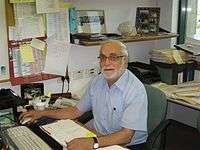Shlomo Havlin
| Shlomo Havlin | |
|---|---|
|
Shlomo Havlin | |
| Born | July 21, 1942 |
| Residence | Bnei Brak, Israel |
| Citizenship | Israel |
| Fields | Physics |
| Institutions | Bar Ilan University |
| Known for | Physical properties of disordered systems |
| Notable awards |
Rothschild Prize for Physical and Chemical Sciences (2014), Yad Hanadiv Lilienfeld Prize (2010) APS(2010); Weizmann Prize for Exact Sciences,(2009); Nicholson Medal, APS(2006) |
Shlomo Havlin (born July 21, 1942) is a Professor in the Department of Physics at Bar-Ilan University, Ramat-Gan, Israel. He served as President of the Israel Physical Society (1996–1999), Dean of Faculty of Exact Sciences (1999–2001), Chairman, Department of Physics (1984–1988).
Biography
Professor Shlomo Havlin was born in Jerusalem, Israel (then part of The British Mandate of Palestine). He graduated from Bar-Ilan and Tel-Aviv Universities with Highest Distinction. He obtained an academic position at Bar-Ilan University in 1972 where he became a full Professor at 1984. During 1978–1979 he was a Royal Society Visiting Fellow at the University of Edinburgh, where he worked with Professors William Cochran and Roger Cowley. In 1984 he became the Chair of the Physics Department at Bar-Ilan University until 1988. During 1983–1984 and 1989–1991, Professor Havlin was a Visiting Scientist at NIH where he collaborated much with Drs. George Weiss, Ralph Nossal and other members of NIH. During 1984–1985 and 1991–1992 he was a Visiting Professor at Boston University, where he collaborated with Professor H. Eugene Stanley.
Centers and research impact
Professor Havlin established four Centers at Bar-Ilan, the Gonda-Goldschmiedt Medical Diagnostic Research Center (1994), the Minerva Center for Mesoscopics, Fractals and Neural Networks (1998), Science Beyond 2000 – Science Education Unit (1996) and Israel Science Foundation National Center for Complex Networks (2003). He was the President of the Israel Physical Society (1996–1999) and the Dean of the Faculty of Exact Sciences at Bar-Ilan University (1999–2001). Professor Havlin had more than 100 graduate students and postdocs, and collaborated with more than 300 scientists around the globe. He published more than 600 articles and 11 books. He is currently in the editorial board of the scientific journals: Fractals,[1] Physica A,[2] New Journal of Physics,[3] Research Letters in Physics[4] and co-editor of Europhysics Letters.[5]
Prizes and awards
Professor Havlin obtained numerous prizes for his outstanding research, including the Landau Prize for Outstanding Research in Physics (1988), the Humboldt Award – Germany (1992), Prize for best scientific paper of 2000, Bar-Ilan University (2000) and Prize for best popular scientific paper, Minister of Science, Israel (2002). He also obtained the Nicholson Medal of the American Physical Society (2006),[6] the Chaim Weizmann Prize for Exact Sciences (2009), the Julius Edgar Lilienfeld Prize for outstanding contribution in physics(2010),[7] and the Rothschild Prize for Physical and Chemical Sciences (2014).[8]
Professor Havlin made many important contributions to science. The following are descriptions of his main contributions in randomness and complexity.
Physical properties of disordered systems
Disordered systems that are self-similar on certain length scales are ubiquitous and often modeled by percolation-type models. The laws that describe transport processes or chemical reactions in these systems are significantly different from those in homogeneous systems. The earlier works of Prof. Havlin, where he discovered several of these important anomalies, had an enormous impact on the development of the whole field and are summarized in the monograph “Diffusion and Reactions in Fractals and Disordered Systems” that he wrote together with his former graduate student Daniel ben-Avraham (Cambridge University Press, 2000). The book describes the anomalous physical laws discovered during 1980-2000 in fractals and disordered systems, many of them by Prof. Havlin and his collaborators. His review article (Adv. in Phys. (1987)) was cited more than 1100 times and was chosen by the journal's editors to be published again (Adv. in Phys. (2002)).
Complex networks
In 2000, Professor Shlomo Havlin and his student Reuven Cohen, together with Prof. Daniel ben-Avraham developed a novel percolation-type approach and derived the first theory on the stability of realistic complex networks such as the Internet under random breakdown (Phys. Rev. Lett. 85, 4626 (2000)) and intentional attacks (Phys. Rev. Lett. 86, 3682 (2001)). This study is particularly useful for optimizing the stability of networks against intentional attacks and viruses. They also derived a novel result about the “small world” nature of complex networks and found that the diameter of scale free networks is significantly smaller and then called them “ultrasmall worlds” (Phys. Rev. Lett. 90, 58701 (2003)). Since 2010, Havlin and collaborators have focused heavily on interdependent networks. His paper with collaborators developed the percolation theory of network of networks (Nature, 464, 08932 (2010)).
Notes
- ↑ "Fractals - Editorial Board". Fractals-Complex Geometry, Patterns, and Scaling in Nature and Society. Retrieved 2008-10-12.
- ↑ "Physica A - Editorial Board". Retrieved 2008-10-12.
- ↑ "New Journal of Physics - Editorial Board". Retrieved 2008-10-12.
- ↑ "Research Letters in Physics - Editorial Board". Retrieved 2008-10-12.
- ↑ "Europhysics Letters - Editorial Board". Retrieved 2008-10-12.
- ↑ "2006 Nicholson Medal". APS. Retrieved 2008-10-10.
- ↑ "2010 Julius Edgar Lilienfeld Prize". APS. Retrieved 2009-12-01.
- ↑ "2014 Rothschild Prize for Physical and Chemical Sciences". Yad Hanadiv. Retrieved 2015-02-18.
